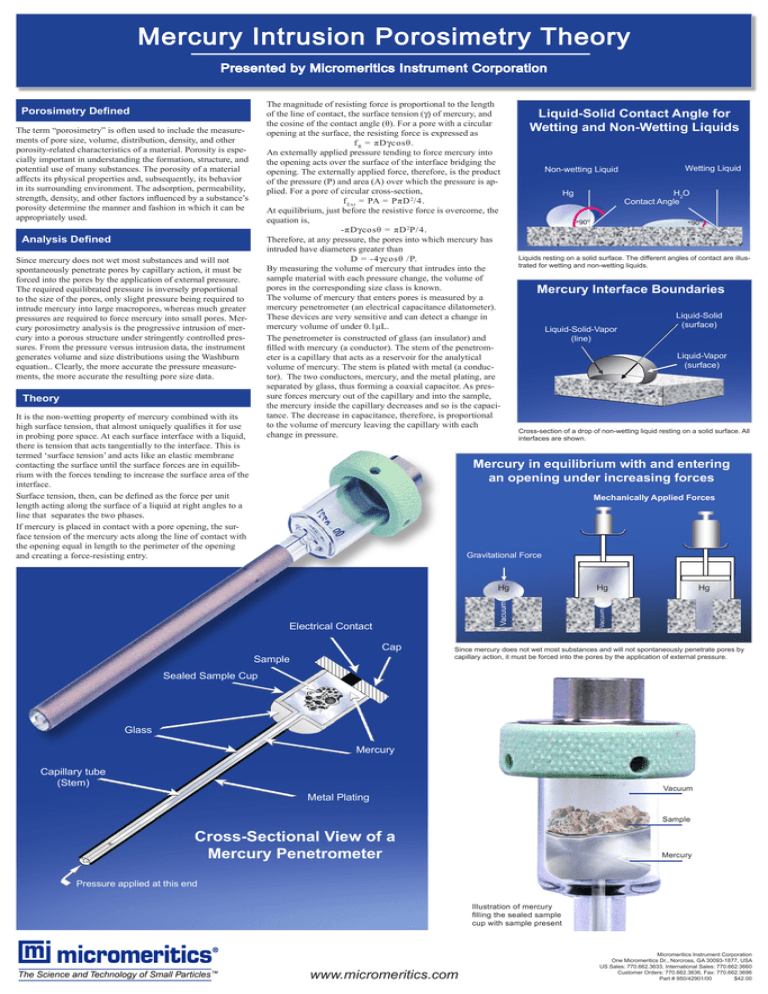Mercury Intrusion Porosimetry Theory
advertisement

Mercury Intrusion Porosimetry Theory Presented by Micromeritics Instrument Corporation The magnitude of resisting force is proportional to the length of the line of contact, the surface tension (g) of mercury, and the cosine of the contact angle (θ). For a pore with a circular opening at the surface, the resisting force is expressed as f R = πDgcosθ. An externally applied pressure tending to force mercury into the opening acts over the surface of the interface bridging the opening. The externally applied force, therefore, is the product of the pressure (P) and area (A) over which the pressure is applied. For a pore of circular cross-section, f Ext = PA = PπD 2 /4. At equilibrium, just before the resistive force is overcome, the equation is, -πDgcosθ = πD 2 P/4. Therefore, at any pressure, the pores into which mercury has intruded have diameters greater than D = -4gcosθ /P. By measuring the volume of mercury that intrudes into the sample material with each pressure change, the volume of pores in the corresponding size class is known. The volume of mercury that enters pores is measured by a mercury penetrometer (an electrical capacitance dilatometer). These devices are very sensitive and can detect a change in mercury volume of under 0.1µL. The penetrometer is constructed of glass (an insulator) and filled with mercury (a conductor). The stem of the penetrometer is a capillary that acts as a reservoir for the analytical volume of mercury. The stem is plated with metal (a conductor). The two conductors, mercury, and the metal plating, are separated by glass, thus forming a coaxial capacitor. As pressure forces mercury out of the capillary and into the sample, the mercury inside the capillary decreases and so is the capacitance. The decrease in capacitance, therefore, is proportional to the volume of mercury leaving the capillary with each change in pressure. Porosimetry Defined The term “porosimetry” is often used to include the measurements of pore size, volume, distribution, density, and other porosity-related characteristics of a material. Porosity is especially important in understanding the formation, structure, and potential use of many substances. The porosity of a material affects its physical properties and, subsequently, its behavior in its surrounding environment. The adsorption, permeability, strength, density, and other factors influenced by a substance’s porosity determine the manner and fashion in which it can be appropriately used. Analysis Defined Since mercury does not wet most substances and will not spontaneously penetrate pores by capillary action, it must be forced into the pores by the application of external pressure. The required equilibrated pressure is inversely proportional to the size of the pores, only slight pressure being required to intrude mercury into large macropores, whereas much greater pressures are required to force mercury into small pores. Mercury porosimetry analysis is the progressive intrusion of mercury into a porous structure under stringently controlled pressures. From the pressure versus intrusion data, the instrument generates volume and size distributions using the Washburn equation.. Clearly, the more accurate the pressure measurements, the more accurate the resulting pore size data. Theory It is the non-wetting property of mercury combined with its high surface tension, that almost uniquely qualifies it for use in probing pore space. At each surface interface with a liquid, there is tension that acts tangentially to the interface. This is termed ‘surface tension’ and acts like an elastic membrane contacting the surface until the surface forces are in equilibrium with the forces tending to increase the surface area of the interface. Surface tension, then, can be defined as the force per unit length acting along the surface of a liquid at right angles to a line that separates the two phases. If mercury is placed in contact with a pore opening, the surface tension of the mercury acts along the line of contact with the opening equal in length to the perimeter of the opening and creating a force-resisting entry. Liquid-Solid Contact Angle for Wetting and Non-Wetting Liquids Non-wetting Liquid Hg Wetting Liquid H 2O Contact Angle >90o <90o Liquids resting on a solid surface. The different angles of contact are illustrated for wetting and non-wetting liquids. Mercury Interface Boundaries Liquid-Solid-Vapor (line) Liquid-Solid (surface) Liquid-Vapor (surface) Cross-section of a drop of non-wetting liquid resting on a solid surface. All interfaces are shown. Mercury in equilibrium with and entering an opening under increasing forces Mechanically Applied Forces Cap Sample Hg Vacuum Electrical Contact Hg Vacuum Gravitational Force Hg Since mercury does not wet most substances and will not spontaneously penetrate pores by capillary action, it must be forced into the pores by the application of external pressure. Sealed Sample Cup Glass Mercury Capillary tube (Stem) Vacuum Metal Plating Sample Cross-Sectional View of a Mercury Penetrometer Mercury Pressure applied at this end Illustration of mercury filling the sealed sample cup with sample present Liquid-Solid-Vapor (line) www.micromeritics.com Micromeritics Instrument Corporation One Micromeritics Dr., Norcross, GA 30093-1877, USA US Sales: 770.662.3633, International Sales: 770.662.3660 Customer Orders: 770.662.3636, Fax: 770.662.3696 Part # 950/42901/00 $42.00




